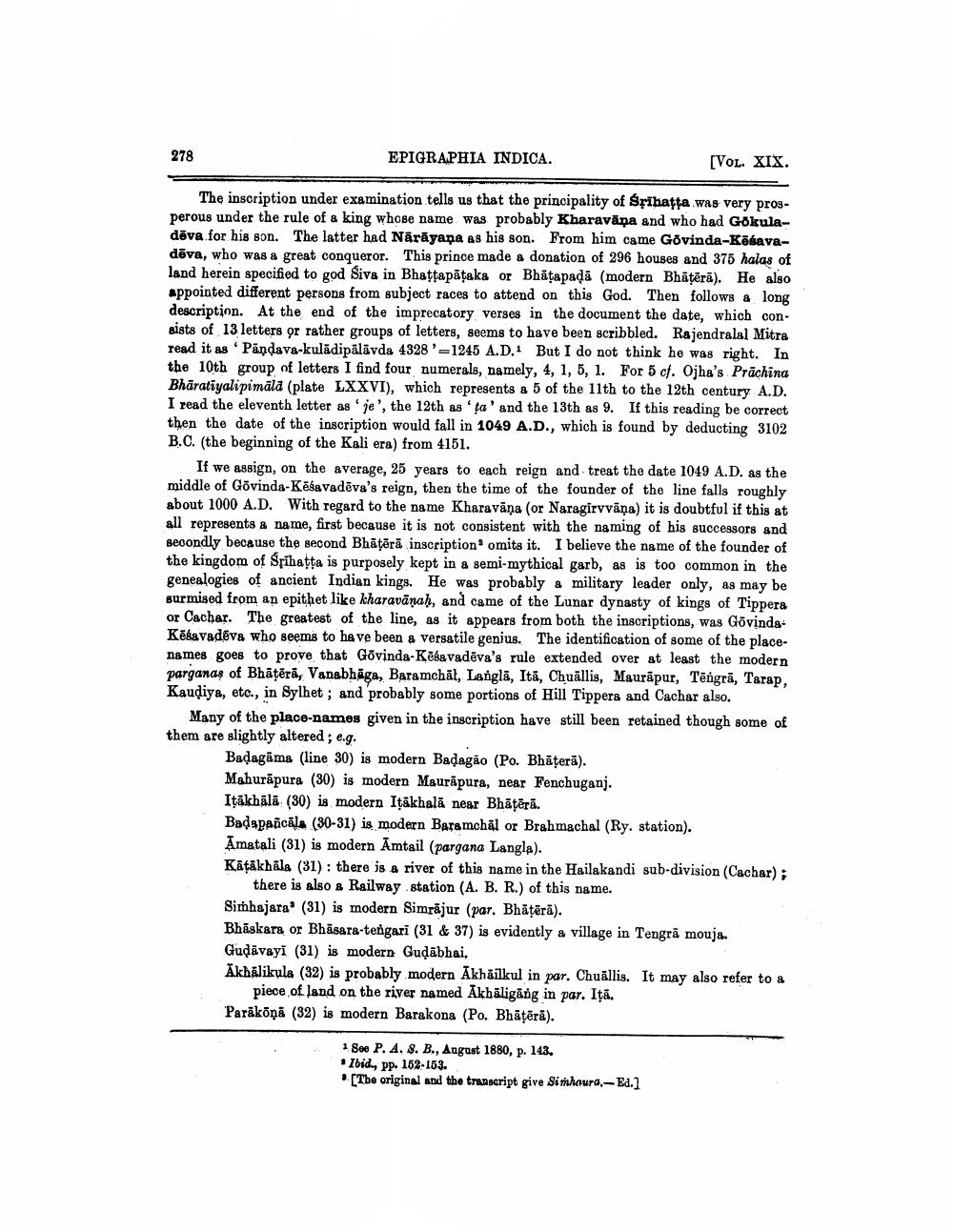________________
278
EPIGRAPHIA INDICA.
[VOL. XIX.
The inscription under examination tells us that the principality of Srihatta was very prosperous under the rule of a king whose name was probably Kharavana and who had Gökuladēva for his son. The latter had Narayana as his son. From him came Govinda-Kōsavadēva, who was a great conqueror. This prince made a donation of 296 houses and 375 halas of land herein specified to god Siva in Bhaṭṭapaṭaka or Bhatapaḍā (modern Bhāṭērā). He also appointed different persons from subject races to attend on this God. Then follows a long description. At the end of the imprecatory verses in the document the date, which consists of 13 letters or rather groups of letters, seems to have been scribbled. Rajendralal Mitra read it as 'Pandava-kulādipälävda 4328'=1245 A.D. But I do not think he was right. In the 10th group of letters I find four numerals, namely, 4, 1, 5, 1. For 5 cf. Ojha's Prachina Bharatiyalipimälä (plate LXXVI), which represents a 5 of the 11th to the 12th century A.D. I read the eleventh letter as 'je', the 12th as 'ta' and the 13th as 9. If this reading be correct then the date of the inscription would fall in 1049 A.D., which is found by deducting 3102 B.C. (the beginning of the Kali era) from 4151.
If we assign, on the average, 25 years to each reign and treat the date 1049 A.D. as the middle of Govinda-Kesavadeva's reign, then the time of the founder of the line falls roughly about 1000 A.D. With regard to the name Kharavana (or Naragirvväņa) it is doubtful if this at all represents a name, first because it is not consistent with the naming of his successors and secondly because the second Bhatera inscription omits it. I believe the name of the founder of the kingdom of Srihaṭṭa is purposely kept in a semi-mythical garb, as is too common in the genealogies of ancient Indian kings. He was probably a military leader only, as may be surmised from an epithet like kharavanaḥ, and came of the Lunar dynasty of kings of Tippera or Cachar. The greatest of the line, as it appears from both the inscriptions, was GovindaKesavadeva who seems to have been a versatile genius. The identification of some of the placenames goes to prove that Govinda-Kesavadeva's rule extended over at least the modern parganas of Bhāṭērā, Vanabhaga, Baramchal, Langla, Ita, Chuallis, Maurapur, Tengra, Tarap, Kaudiya, etc., in Sylhet; and probably some portions of Hill Tippera and Cachar also.
Many of the place-names given in the inscription have still been retained though some of them are slightly altered; e.g.
Badagama (line 30) is modern Badagão (Po. Bhāṭerā).
Mahurāpura (30) is modern Maurapura, near Fenchuganj.
Iṭākhālā (30) is modern Itäkhală near Bhāṭērā.
Badapancala (30-31) is modern Baramchal or Brahmachal (Ry. station).
Amatali (31) is modern Amtail (pargana Langla).
Kätäkhala (31): there is a river of this name in the Hailakandi sub-division (Cachar);
there is also a Railway station (A. B. R.) of this name.
Simhajara (31) is modern Simrajur (par. Bhāṭērā).
Bhaskara or Bhasara-tengari (31 & 37) is evidently a village in Tengra mouja.
Gudavayi (31) is modern Guḍābhai,
Akhalikula (32) is probably modern Akhäilkul in par. Chuallis. It may also refer to a
piece of land on the river named Akhaligang in par. Ita.
Parākoņā (32) is modern Barakona (Po. Bhāṭērā).
1. See P. A. 8. B., August 1880, p. 143. Ibid., pp. 152-153.
3 [The original and the transcript give Simhaura.-Ed.]




